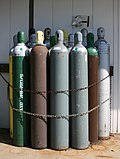Bottled gas
Bottled gas is a term used for substances which are gaseous at standard temperature and pressure (STP) and have been compressed and stored in carbon steel, stainless steel, aluminum, or composite bottles known as gas cylinders.
History
The use of bottled gas dates back to the early 20th century. The concept was developed to allow for the easy distribution and use of gases in a portable manner. The first bottled gases were used for industrial processes and were later adopted for a variety of other applications.
Production
Bottled gas is produced through a process of compression, purification and, in some cases, chemical reactions. The gas is first compressed to a pressure that allows it to be stored in a liquid state. It is then purified to remove any impurities. In some cases, the gas may undergo a chemical reaction to produce the desired end product.
Types
There are several types of bottled gas, including but not limited to:
- Propane: Used for heating, cooking, and as a fuel for engines, oxy-gas torches, barbecues, portable stoves, and residential central heating.
- Butane: Used as a fuel for cigarette lighters and portable stoves.
- Oxygen: Used in medical applications, high-altitude climbing, and as an oxidizer in rocketry.
- Nitrous oxide: Used as an aerosol propellant and in making whipped cream, as well as in medicine for its anaesthetic effects.
- Carbon dioxide: Used as a refrigerant, in fire extinguishers, for inflating life rafts and life jackets, and as a propellant for paintball markers.
Safety
Bottled gas is generally safe to use, but it is important to handle it with care due to its high pressure. It is recommended to store bottled gas in a well-ventilated area and away from heat sources. It is also important to use the correct regulator and hose for the type of gas being used.
Environmental Impact
While bottled gas is a cleaner-burning fuel than coal or oil, it is still a fossil fuel and its use contributes to global warming. However, advances in technology are leading to cleaner and more efficient ways to produce and use bottled gas.
See Also
Transform your life with W8MD's budget GLP-1 injections from $125.
W8MD offers a medical weight loss program to lose weight in Philadelphia. Our physician-supervised medical weight loss provides:
- Most insurances accepted or discounted self-pay rates. We will obtain insurance prior authorizations if needed.
- Generic GLP1 weight loss injections from $125 for the starting dose.
- Also offer prescription weight loss medications including Phentermine, Qsymia, Diethylpropion, Contrave etc.
NYC weight loss doctor appointments
Start your NYC weight loss journey today at our NYC medical weight loss and Philadelphia medical weight loss clinics.
- Call 718-946-5500 to lose weight in NYC or for medical weight loss in Philadelphia 215-676-2334.
- Tags:NYC medical weight loss, Philadelphia lose weight Zepbound NYC, Budget GLP1 weight loss injections, Wegovy Philadelphia, Wegovy NYC, Philadelphia medical weight loss, Brookly weight loss and Wegovy NYC
|
WikiMD's Wellness Encyclopedia |
| Let Food Be Thy Medicine Medicine Thy Food - Hippocrates |
Medical Disclaimer: WikiMD is not a substitute for professional medical advice. The information on WikiMD is provided as an information resource only, may be incorrect, outdated or misleading, and is not to be used or relied on for any diagnostic or treatment purposes. Please consult your health care provider before making any healthcare decisions or for guidance about a specific medical condition. WikiMD expressly disclaims responsibility, and shall have no liability, for any damages, loss, injury, or liability whatsoever suffered as a result of your reliance on the information contained in this site. By visiting this site you agree to the foregoing terms and conditions, which may from time to time be changed or supplemented by WikiMD. If you do not agree to the foregoing terms and conditions, you should not enter or use this site. See full disclaimer.
Credits:Most images are courtesy of Wikimedia commons, and templates, categories Wikipedia, licensed under CC BY SA or similar.
Translate this page: - East Asian
中文,
日本,
한국어,
South Asian
हिन्दी,
தமிழ்,
తెలుగు,
Urdu,
ಕನ್ನಡ,
Southeast Asian
Indonesian,
Vietnamese,
Thai,
မြန်မာဘာသာ,
বাংলা
European
español,
Deutsch,
français,
Greek,
português do Brasil,
polski,
română,
русский,
Nederlands,
norsk,
svenska,
suomi,
Italian
Middle Eastern & African
عربى,
Turkish,
Persian,
Hebrew,
Afrikaans,
isiZulu,
Kiswahili,
Other
Bulgarian,
Hungarian,
Czech,
Swedish,
മലയാളം,
मराठी,
ਪੰਜਾਬੀ,
ગુજરાતી,
Portuguese,
Ukrainian
Contributors: Prab R. Tumpati, MD




